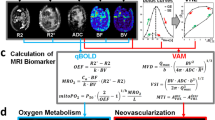Abstract
Background. The endothelial integrity of microvessels is disrupted in malignant tumors. Quantitative assays of tumor microvascular characteristics based on dynamic magnetic resonance imaging (MRI) were correlated with histopathologic grade in mammary soft tissue tumors. Materials and methods. A spectrum of tumors, benign through highly malignant, was induced in 33 female rats by administration of N -ethyl-N -nitrosourea (ENU), a potent carcinogen. Dynamic contrast-enhanced MRI was performed using a small-molecular contrast medium [gadopentetate, MW = 0.5 kDa] and a macromolecular contrast medium [albumin-(Gd-DTPA)30, MW = 92 kDa] at an interval of 1–2 days. Permeability surface area product (PS), as estimated by the corresponding endothelial transfer coefficient (KPS), and fractional plasma volume (fPV) were calculated for each tumor and each contrast agent using a two-compartment bi-directional kinetic model. MRI microvascular characteristics were correlated with histopathologic tumor grade. Results. Tumor permeability to macromolecular contrast medium, characterized by KPS, showed a highly positive correlation with tumor grade (r 2 = 0.76, P < 10− 10). KPS values were zero for all benign and some low-grade carcinomas, greater than zero in all other carcinomas, and increased in magnitude with higher tumor grade. A considerably smaller but significantly positive correlation was found between fPV and tumor grade using macromolecular contrast medium (r 2 = 0.25, P < 0.003). No correlation between KPS or fPV values and tumor grade was found using gadopentetate (r 2 = 0.01, P > 0.95 and r 2 = 0.03, P > 0.15, respectively). Conclusion. Quantitative tumor microvascular permeability assays generated with macromolecular MRI contrast medium correlate closely with histologic tumor grade. No significant correlation is found using small-molecular gadopentetate.
Similar content being viewed by others
Author information
Authors and Affiliations
Additional information
Received: 26 August 1997 Accepted: 21 October 1997
Rights and permissions
About this article
Cite this article
Daldrup, H., Shames, D., Wendland, M. et al. Correlation of dynamic contrast-enhanced magnetic resonance imaging with histologic tumor grade: comparison of macromolecular and small-molecular contrast media. Pediatric Radiology 28, 67–78 (1998). https://doi.org/10.1007/s002470050296
Issue Date:
DOI: https://doi.org/10.1007/s002470050296




